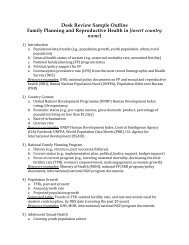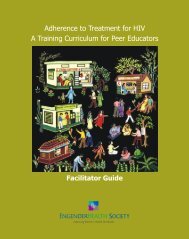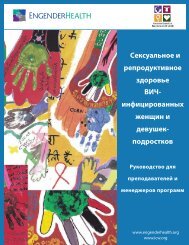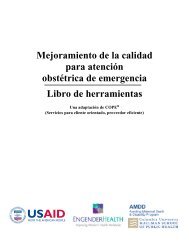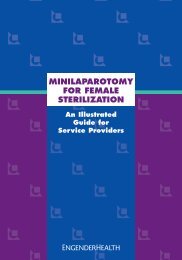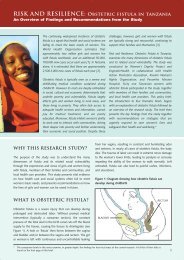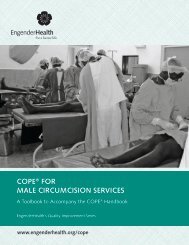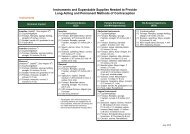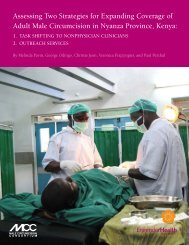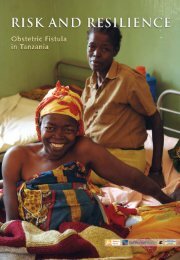Help-Seeking Pathways and Barriers for ... - EngenderHealth
Help-Seeking Pathways and Barriers for ... - EngenderHealth
Help-Seeking Pathways and Barriers for ... - EngenderHealth
You also want an ePaper? Increase the reach of your titles
YUMPU automatically turns print PDFs into web optimized ePapers that Google loves.
Part I: Background<br />
A. Context of GBV in Tanzania<br />
During the last few decades, gender-based violence (GBV) has gained international<br />
recognition as a grave social <strong>and</strong> human rights concern. In Tanzania, GBV is widespread. In<br />
the 2010 TDHS, over 20% of Tanzanian women aged 15-49 years reported having<br />
experienced sexual violence in their lifetime <strong>and</strong> nearly 40% reported having experienced<br />
physical violence. 2 The same survey showed that 44% of ever-married women had<br />
experienced physical <strong>and</strong>/or sexual violence from an intimate partner in their lifetime.<br />
Disaggregated data <strong>for</strong> GBV among women in the regions examined in the current study are<br />
shown in Table 1. A nationally representative survey of violence against children also found<br />
that nearly 75% of girls <strong>and</strong> boys had experienced physical violence (either by an adult or<br />
intimate partner) by the age of 18 years, <strong>and</strong> that nearly 3 in 10 girls had experienced<br />
sexual violence be<strong>for</strong>e reaching adulthood. 3<br />
Table 1: Prevalence of physical <strong>and</strong> sexual violence by region, women aged<br />
15-49 years<br />
Region Ever experienced physical violence Ever experienced sexual violence<br />
All Tanzania 38.7% 20.3%<br />
Dar es Salaam 31.8% 24.1%<br />
Iringa 42.3% 26.5%<br />
Mbeya 48.8% 30.8%<br />
Source: NBS et al. (2011).<br />
Despite this high prevalence of violence, <strong>for</strong>mal support services <strong>for</strong> survivors are<br />
inadequate. Although there is a growing awareness of GBV <strong>and</strong> increased ef<strong>for</strong>ts at a policy<br />
level to address the issue, survivors’ access to health, psychosocial, <strong>and</strong> legal services<br />
remains limited. For example, there are few known shelters <strong>for</strong> survivors in Tanzania <strong>and</strong><br />
these are predominantly located in Dar es Salaam. 4 Moreover, an overall shortage of trained<br />
medical professionals in the country has implications <strong>for</strong> the availability of GBV-specific<br />
care.<br />
To increase the availability <strong>and</strong> quality of services available to survivors of GBV in Dar es<br />
Salaam, Iringa, <strong>and</strong> Mbeya, the U.S. President’s Emergency Plan <strong>for</strong> AIDS Relief (PEPFAR)<br />
has launched a multi-sectoral intervention based on five key pillars: 1) services; 2)<br />
prevention <strong>and</strong> community protection; 3) advocacy; 4) coordination; <strong>and</strong> 5) research <strong>and</strong><br />
evaluation.<br />
2 NBS et al. (2011).<br />
3 United Nations Children’s Fund (UNICEF), Centers <strong>for</strong> Disease Control <strong>and</strong> Prevention (CDC), & Muhimbili<br />
University of Health <strong>and</strong> Allied Services (MUHAS). (2011). Violence against children in Tanzania: Findings<br />
from a National Survey 2009. Dar es Salaam: UNICEF, CDC, & MUHAS. August 2011.<br />
4 Betron, M. (2008). Gender-based violence in Tanzania: An assessment of policies, programs, <strong>and</strong><br />
promising interventions. Washington, D.C.: USAID Health Policy Initiative.<br />
<strong>Help</strong>-<strong>Seeking</strong> <strong>Pathways</strong> <strong>and</strong> <strong>Barriers</strong> <strong>for</strong> Survivors of GBV in Tanzania March 2013<br />
Page 10




